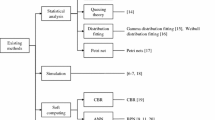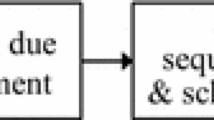Abstract
Cycle time is the time required for a job to be processed by a factory including the time required for processing, transportation, and waiting. Estimating the cycle time of each job is a critical concern in managing a factory. To address this concern, classifying approaches in which jobs are classified before or after forecasting their cycle times have recently been proposed. However, none of these approaches can guarantee the compatibility of the job classifier with the forecasting mechanism. To overcome this difficulty, a new classifying approach is proposed in this study. In the proposed methodology, the training of the forecasting mechanism is embedded into the iterations of the job classifier. Consequently, the classification and forecasting stages interweave with each other, improving their compatibility. The proposed methodology was tested using data on 120 jobs. According to the results, the proposed methodology surpassed five existing methods in forecasting accuracy. Compared with two existing classifying approaches, the proposed methodology statistically significantly reduced the mean absolute percentage error by 56 and 38 % for testing and unlearned data, respectively.









Similar content being viewed by others
References
Bezdek JC (1981) Pattern recognition with fuzzy objective function algorithms. Plenum Press, New York
Chang P-C, Wang Y-W, Liu C-H (2006) Combining SOM and GA-CBR for flow time prediction in semiconductor manufacturing factory. Lect Notes Comput Sci 4259:767–775
Chen T (2003) A fuzzy back propagation network for output time prediction in a wafer fab. Appl Soft Comput 2(3):211–222
Chen T (2006) A hybrid SOM-BPN approach to lot output time prediction in a wafer fab. Neural Process Lett 24(3):271–288
Chen T (2007) An intelligent hybrid system for wafer lot output time prediction. Adv Eng Inform 21:55–65
Chen T (2008) A SOM-FBPN-ensemble approach with error feedback to adjust classification for wafer-lot completion time prediction. Int J Adv Manuf Technol 37(7–8):782–792
Chen T (2009) Job remaining cycle time estimation with a post-classifying fuzzy-neural approach in a wafer fabrication plant. Proc Inst Mech Eng Part B J Eng Manuf 223:1021–1031
Chen T (2011) Job cycle time estimation in a wafer fabrication factory with a bi-directional classifying fuzzy-neural approach. Int J Adv Manuf Technol 56(9):1007–1018
Chen T (2013) An effective fuzzy collaborative forecasting approach for predicting the job cycle time in wafer fabrication. Comput Ind Eng 66:834–848
Chen T (2015) Combining statistical analysis and artificial neural network for classifying jobs and estimating the cycle times in wafer fabrication. Neural Comput Appl 26(1):223–236
Elmazi D, Kulla E, Oda T, Spaho E, Sakamoto S, Barolli L (2015) A comparison study of two fuzzy-based systems for selection of actor node in wireless sensor actor networks. J Ambient Intell Humaniz Comput 6(5):635–645
Hassoun M (2013) On improving the predictability of cycle time in an NVM fab by correct segmentation of the process. IEEE Trans Semicond Manuf 26(4):613–618
Hsieh LY, Chang KH, Chien CF (2014) Efficient development of cycle time response surfaces using progressive simulation metamodeling. Int J Prod Res 52(10):3097–3109
Joseph OA, Sridharan R (2011) Analysis of dynamic due-date assignment models in a flexible manufacturing system. J Manuf Syst 30(1):28–40
Lu SCH, Ramaswamy D, Kumar PR (1994) Efficient scheduling policies to reduce mean and variation of cycle time in semiconductor manufacturing plant. IEEE Trans Semicond Manuf 7:374–388
Matteucci (2013) Fuzzy c-means clustering. http://home.deib.polimi.it/matteucc/Clustering/tutorial_html/cmeans.html
Srivastava V, Tripathi BK, Pathak VK (2014) Biometric recognition by hybridization of evolutionary fuzzy clustering with functional neural networks. J Ambient Intell Humaniz Comput 5(4):525–537
Vinod V, Sridharan R (2011) Simulation modeling and analysis of due-date assignment methods and scheduling decision rules in a dynamic job shop production system. Int J Prod Econ 129(1):127–146
Wein LM (1998) Scheduling semiconductor wafer fabrication. IEEE Trans Semicond Manuf 1:115–130
Wu H-C, Chen T (2015) CART–BPN approach for estimating cycle time in wafer fabrication. J Ambient Intell Humaniz Comput 6:57–67
Acknowledgments
This study was supported by the Ministry of Science and Technology of Taiwan.
Author information
Authors and Affiliations
Corresponding author
Rights and permissions
About this article
Cite this article
Chen, T. Embedding a back propagation network into fuzzy c-means for estimating job cycle time: wafer fabrication as an example. J Ambient Intell Human Comput 7, 789–800 (2016). https://doi.org/10.1007/s12652-015-0336-1
Received:
Accepted:
Published:
Issue Date:
DOI: https://doi.org/10.1007/s12652-015-0336-1




